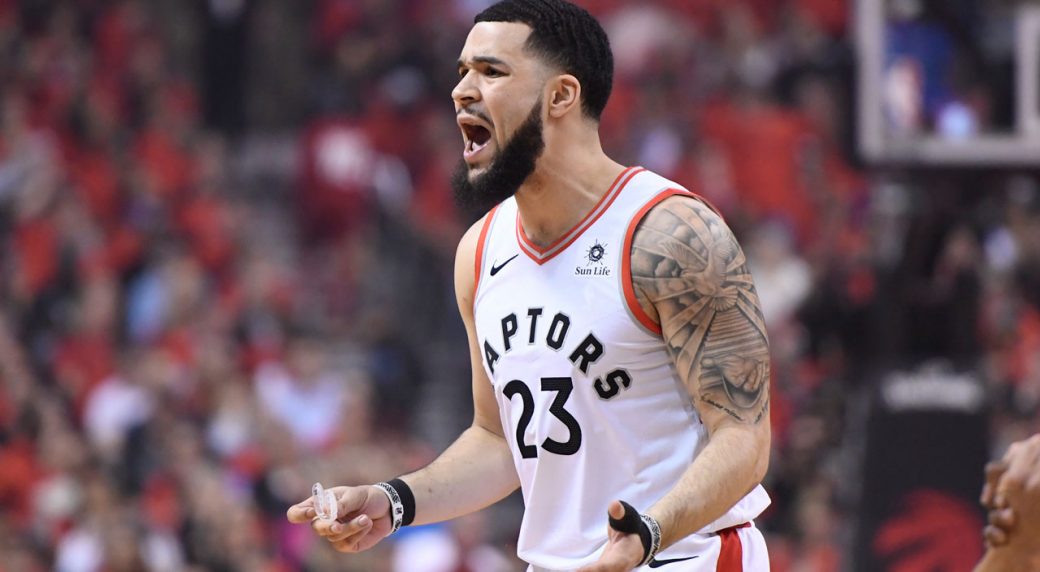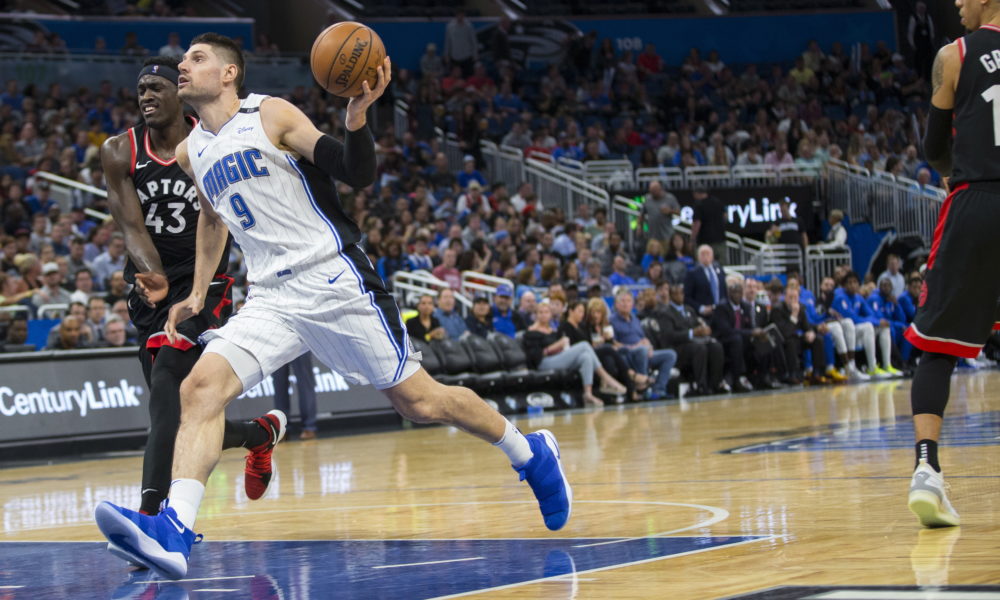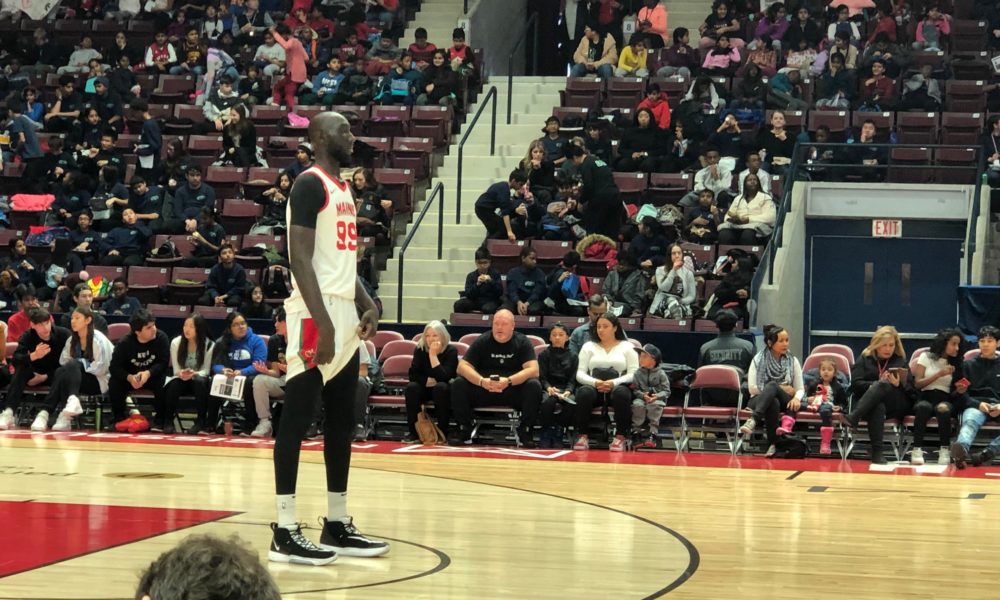John Steinbeck’s protagonist, Kino, has a tough go of it in The Pearl. He finds a massive pearl, the size of a seagull’s egg, and his newfound wealth brings ruin to his formerly idyllic home life. Eventually, Kino loses his family, his mind, and eventually, even his pearl. Though a deserving family initially finds great fortune, it has horrible consequences; the story is a sad one.
Great fortune, if managed poorly, can be one’s demise.
Masai Ujiri and the Toronto Raptors have found a pearl of unbelievable size in Fred VanVleet. His origin story is gospel at this point, but he is doing things that virtually no undrafted player has ever done. Thus far on the season, he is averaging 17.2 points, 7.6 assists, 4.0 rebounds, and 1.8 steals per game, while shooting 39.5 percent from deep. The number of players in history who’ve done that over a season can be counted on two hands, and it includes Steph Curry, Larry Bird, John Stockton, and Chris Paul. Mark Price was the lowest picked, at 25th overall. VanVleet is accomplishing feats hitherto unheard of for his draft placement.
Signing VanVleet has massively benefited Toronto. Hitting the lottery on marginal roster moves can change a franchise’s fortune. It’s not hyperbole to say that Toronto probably wouldn’t have won a championship last year without VanVleet. And then he went and improved his game over the summer, becoming even more foundational to Toronto’s success this year. If they are a championship contender again, VanVleet’s improvement is one of the key reasons why.
VanVleet’s defensive acumen has been well known to the initiated for some time. Matchup data often tells a faulty story in the details, but the big picture is clear when it comes to VanVleet. Just this season, he’s held star scorers to horrible games as their primary defenders. He held Kemba Walker to 3-of-9 shooting in 30.9 possessions. Damian Lillard felt the clamps, shooting 0-of-6 with VanVleet as his primary defender over 26.7 possessions. De’Aaron Fox shot 2-of-5 with four turnovers in 22.8 possessions. These are guards supposed to outclass any opponent, but instead VanVleet shone brightest.
Just as impressive is VanVleet’s Lowryian ability to ably defend far larger wings and even bigs on switches. Clumping all of VanVleet’s matchup data into a ball, he’s held all non-guards to 18-of-42 shooting. He uses his strength to bother shots from much bigger players.
VanVleet cares desperately about getting stops. Pascal Siakam admitted that VanVleet sometimes gets angry with teammates for helping him in the post against bigs. VanVleet takes those matchups personally, and “it’s great to have a guy like that on your team,” admitted Siakam, even if he would prefer VanVleet to be a little more accepting of help.
VanVleet is a pitbull chasing people off the ball, with the strength and low center of gravity to keep opponents off-balance. He’s perfectly designed to bother elite relocation shooters like JJ Redick or Steph Curry. VanVleet is ferocious on the ball, and he’s switchable 1-3 and onto the occasional 4. No matter where he is on the court, VanVleet impacts good defense. Toronto wants VanVleet on the perimeter, though, where he digs into the post, is great at doubling, and forces plenty of turnovers. Per pbpstats, Toronto’s live ball turnover rate is 8 percent higher with VanVleet on the court this year. He’s exceptionally strong, and he often gets his hands on the ball if opponents slow their drive in the face of help.
VanVleet may be short, and he may have a short wingspan, but he has other physical advantages: strength, quickness, great feet and hands, and a low center of gravity. Those help, but his real brilliance derives from his mental qualities. VanVleet thinks the game in a cerebral way, always knowing when he can help and when to stay fixed to his man. He always funnels his offender to the correct places. Sure, VanVleet held Lillard to 0-of-6 shooting in his minutes on the All-Star, but it was primarily a result of VanVleet playing picturesque defense within the structure of team principles.
Here he ices the screen, forcing Lillard away from the pick and towards a knot of help defenders.
Even when VanVleet is a step slow, he uses angles and the positioning of the team defensive structure to fight back into the play.
“His defence is great,” said Siakam. “I think that’s always one of the things that Fred’s been able to do, and his instincts are really good.”
“You go out there and most nights I feel pretty good that he’s gonna be able to guard his matchup, I think he’s been awesome defensively,” agreed Nick Nurse.
On the other end, VanVleet has improved dramatically. He’s always been a phenomenal spot-up shooter. This year he’s shot 50 percent from deep on catch-and-shoot attempts, and he’s never shot worse than 40 percent in his career. Like his defense, his spot-up shooting has never been in doubt. But he’s added more this year, becoming a far more frequent on-ball player.
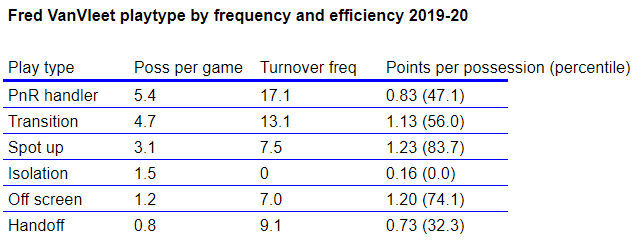
VanVleet’s ball-dominant ways are not new to 2019-20. It’s been a multi-year transition, with VanVleet finishing more plays in the pick-and-roll than off the catch both in 2017-18 and 2018-19. Toronto is starting to see dividends for the first time this year. Last year, Toronto’s net rating with VanVleet on and Kyle Lowry and Kawhi Leonard off was -3.8, as the offense plummeted in those minutes. VanVleet couldn’t stabilize Toronto offensively without stars alongside him. This year, with VanVleet on and Lowry off, Toronto has a net rating of +4.4 with a reasonable offense. VanVleet is excellent in transition, and he runs as much as possible when he’s the lead guard. His decision making is fantastic when defenders are on the move.
VanVleet is improving at running Toronto’s offense as the sole initiator, even in the half-court. He’s been force-fed on-ball reps; his pick-and-roll and isolation attempts have risen much faster than his corresponding spot-up and off-screen attempts. He has a great crossover with the ball, and it lets him get to his spots fairly well. His decision-making has improved when he gets near the rim, and he’s better at keeping his dribble alive, forcing the defense to commit before he makes his choices. It is somewhat problematic that his scoring efficiency hasn’t risen in concert with his on-ball usage, but his assist rate has sky-rocketed to 29.4, top-30 in the league and highest on the Raptors. VanVleet has become a far better passer, if not necessarily a better scorer, with the ball in his hands. He doesn’t dribble more, on average, this year than in years past. He’s more efficient with his movements, more decisive attacking defenses, and better creating and capitalizing on mistakes from his opponents. He’s starting to manipulate defenders.
Of course, there are downsides to VanVleet’s offensive performance. He’s not close to the level of elite offensive point guards like Kyle Lowry or Kyrie Irving, and much of that is because of his finishing ability at the rim. He can get to the rim, but he turns the ball over too much, and he isn’t as dependable a finisher as the best guards. As a result, when defenders force him off the arc and make him drive into help, he doesn’t have the ability to create hyper-efficient shots for himself. In that area, he hasn’t improved dramatically since he entered the NBA.
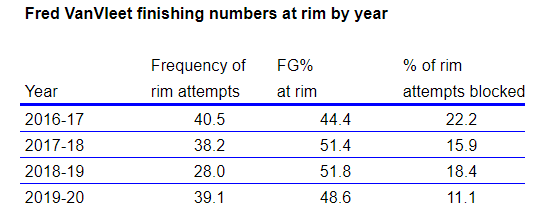
For the record, Kemba Walker was blocked more total than any other player in the NBA last year, and he was blocked on 17.4 percent of attempts at the rim. VanVleet has been better, but he’s in the same category. Even when he isn’t blocked, he hasn’t been a consistent finisher. He doesn’t have perfect touch with his arm deceleration, so even when he creates open layups, he will flub some when his body is flying full speed past the basket. Furthermore, VanVleet doesn’t have nearly enough release points to compensate for his size. He can leave his feet without creating separation, and he doesn’t have the athleticism or rangy release to keep the ball away from his defenders.
On the other hand, VanVleet has a great core and can bounce off of challengers in the air. When he can see where the weak-side defender is coming from, his finishing can look impressive.
As a point of comparison with another undersized guard, Kyle Lowry has shot at least 60 percentage at the rim every year since 2016-17. Because he seems to have a better feel for defenders’ presence and momentum, Lowry is blocked far less often. For the record, it took Lowry a long time to reach this All-NBA peak. Over Lowry’s first four years, he shot 51.7 percent at the rim, similar to VanVleet’s first four. So VanVleet has plenty of time to improve. Not everyone develops like Lowry, and it’s fair to wonder if VanVleet will get there, but he’s made strides in enough other areas that it’s a believable next step forward.
Despite playing far more minutes than ever before, and having a higher usage rate when he is on the court, VanVleet has not lost any efficiency as a scorer this year. He’s improved his ability to get to the line and completely eschewed shots that aren’t at the rim or from deep. He hoists too many late-clock grenades for the injured version of the Raptors, and that diminishes his efficiency numbers. He was a better scorer when Lowry and Ibaka were healthy and could carry more load. VanVleet can support a solid amount of a team’s offense, even if he needs elite talent alongside him to unlock his peak.
Taken from a bird’s-eye view, 2019-20 constitutes development for VanVleet in a number of areas. With his elite defense and ability to contribute in multiple ways offensively, it’s clear that he’s ready to be a starting point guard on a playoff caliber team. That wasn’t obvious last year.
VanVleet being this good changes the Raptors. It’s not a stretch to say that VanVleet is in the upper echelon of two-way point guards in the league, and his numbers believably suggest some All-Star votes will go his way. There are flaws in his game, but he has plenty of spectacular highlights, and he’s led Toronto to a big number of wins. His per-game averages are either equal to or better than D’Angelo Russell in 2019 or Goran Dragic in 2018.
Asked if he would argue for VanVleet in the All-Star game, Nurse laughed and said he hasn’t thought about it, but added “sure, why not?”
Yes, VanVleet is still a relatively low-level finisher. He has never shot better than 42 percent on drives in his career. Length bothers him quite a bit. If he didn’t have those flaws on the offensive end, he would be a max player, and we would be talking about VanVleet in the same breath as prime Deron Williams. Everyone in the NBA save a handful of guys have weaknesses, and VanVleet is no exception. He obviously has room to grow, but it’s encouraging when you look at how much he’s already developed. He’s 25 years old and has yet to reach his prime.
No matter what happens, VanVleet will receive a monstrous pay bump over his current $9 million per year. Last summer, Bojan Bogdanovic signed for $73 million over four years, Malcolm Brogdon for $85 million over four, and Terry Rozier for $58 million over three. VanVleet is in that category of guards now, far superior to the George Hills and Patrick Beverlys of the world, but not quite in the stratosphere of the Kyrie Irvings and Kemba Walkers. It’s not crazy to think VanVleet will command $20 million per year in free agency this summer. There won’t be many better free agents this summer.
Where would that leave Toronto? This upcoming off-season, when VanVleet hits the market, already constitutes a punt for the franchise. Lowry’s $30 million legacy deal eats into what flexibility the Raptors had. That doesn’t matter. The free agents projected to be available aren’t great, and Toronto doesn’t care about 2020-21 free agency anyway.
2021-22 is when the whales hit the market. Currently, the Raptors owe $46.5 million in salaries committed to 2021-22. That’s not an accident. Toronto has long been building its financials with one goal in mind: Giannis Antetokounmpo. By all accounts, Toronto will have a real shot at him. With the salary cap projected to be $125 million in 2021-22, a stripped-down Toronto would have two max slots with which to play. Other potential free agents that summer include Kawhi Leonard, LeBron James, Paul George, Jrue Holiday, Bradley Beal, and Victor Oladipo. The Raptors will make a run at some big names, and they’ve been hoarding their money for Antetokounmpo and a friend.
VanVleet changes those projections. The team has spent maybe half a decade maneuvering to have space for the summer of 2021-22. Now Ujiri and company need to weigh if VanVleet is worth using so much of that treasure preemptively. If Toronto retains him at $20 million per year, on top of a huge extension for OG Anunoby, there would quickly be an extra $40 million or more per year on the sheet. Toronto would instantly lose one 2021-22 max spot, and an extension to any of Lowry, Terence Davis, Pat McCaw, or another player on the roster could jeopardize the Raptors’ second max spot.
That’s inconceivable to the brain trust. Antetokounmpo is the light at the end of the tunnel, the promise of eternal paradise. Toronto has spent too long building towards that summer to bow out of the race before it begins. Toronto needs at least $37.5 million — 30 percent, the maximum allowable amount of the projected cap for one player — free for the summer of 2021-22. No matter what.
There are ways for the Raptors to dance around the cap mechanics. They could wait to sign Anunoby until after they use their available cap space in 2021-22, which would mean he’d only count towards a smaller cap hold of approximately $11.6 million. Anunoby could — like Siakam before this season — prefer to extend his contract before 2021-22, meaning the Raptors wouldn’t be able to use that maneuver to save space for Antetokounmpo. It’s tough to predict how these things will go.
Still, it’s possible the Raptors could re-sign VanVleet and Anunoby and keep that golden $37.5 milion free. But they certainly can’t re-sign their young core and keep a second max slot free. The Raptors have an incredible group of young talent, and the team has, as a result, continued to win games despite injuries to Lowry and Serge Ibaka. It’s expensive to keep great young players after rookie deals, and VanVleet popping only increases the cost.
In some scenarios, retaining VanVleet could necessitate losing Anunoby. I don’t know who the Raptors would choose between VanVleet and Anunoby, but I would bet on the latter. Players like Davis, Norm Powell, or Matt Thomas would have to be shed for nothing to keep a max slot available, and it would be tricky to keep any of the vets in Lowry, Serge Ibaka, and Marc Gasol. There is a cost beyond dollars to keeping VanVleet at the price he’ll command.
Siakam, Anunoby, and VanVleet are very good. They are all fantastic defenders, and they compliment each other, positionally, stylistically, and even emotionally. It matters that the young guys care about each other. VanVleet and Siakam are close friends off the court, and they consistently refer to each other as brothers and each other’s favourite players. They’ve been together through the G League, the end of the bench, the bench mob, the championship, and now co-starring.
“It’s just been fun to be there alongside of him, and if I can stick by his side, maybe I’ll stick around long enough and soak up some of that max money,” joked VanVleet.
“He’s like my brother,” agreed Siakam.
It’s reasonable to think that VanVleet, Siakam, and Anunoby have improved and will continue to improve in tandem. They’re as good a young foundation as exists in the league, minus a few teams who’ve spent years building through the top of the draft. Perhaps Davis or Chris Boucher pops for Toronto, as well. But even assuming best-case development, that group on its own is not good enough to win another championship, and Toronto has made it clear that the mountaintop is their ultimate destination. Toronto learned in the DeMar DeRozan trade that the NBA is a business first and a family second. Front offices and especially fan bases can form emotional attachments to players like VanVleet, but that won’t impact his free agency.
VanVleet’s ascendancy has constituted Toronto playing with house money, particularly as he’s massively outplayed his contracts. But going forward, there’s a cost if Toronto bets wrong. If Toronto keeps VanVleet, and he doesn’t ever develop into the type of winning point guard that Lowry became in Toronto, he may well be overpaid for the next several years. He is the league’s least efficient isolation player this year, and it’s possible he never becomes a plus scorer in the half-court. $20 million for an undersized 3-and-D point guard could look bad, especially as it would cost Toronto cap space in the monstrous free agent pool of 2021-22. As the Raptors would need to shed money, the team’s depth would be depleted. Could VanVleet still lift that roster? How much talent does he need beside him for his defense and off-ball shooting to shine?
Toronto could decide VanVleet’s upcoming salary is too rich for its blood. Maybe some team offers him so much that Toronto can’t compete. If Ujiri lets VanVleet sign elsewhere, and the precious cap space retained as a result goes fallow, with no star choosing to sign in Toronto, the Raptors would be left exactly where they started. Toronto would be a solid playoff team behind Siakam and Anunoby, with no real shot at making noise in later rounds. That’s not a disaster, but it’s also not what the team has spent years building towards.
Antetokounmpo coming to Toronto, obviously, would solve all the problems. He’d be unstoppable next to Siakam, and like Malcolm Brogdon in Milwaukee, VanVleet would be an ideal low-usage point guard. Signing a top-three player in the league answers over a lot of questions. But if Toronto thinks he’s coming, they have to decide if a new contract for VanVleet is the best use of available funds to compliment the superstar.
There are multiples ways in which VanVleet’s upcoming free agency could hurt Toronto, whether he stays or goes. These are hypotheticals, and they constitute unknowable futures. On one hand, it’s silly to guess at what might happen. But that’s exactly what Toronto has to do. And the better VanVleet plays, the more that guess will cost, regardless of what the franchise chooses.
There can be hidden costs to finding a pearl in the depths of the ocean. Fred VanVleet has made himself into an undrafted success story of an almost unprecedented caliber. Both Toronto and VanVleet himself have benefited greatly. But great fortune, managed poorly, can become great tragedy. Toronto needs to choose wisely as the story unfolds.

